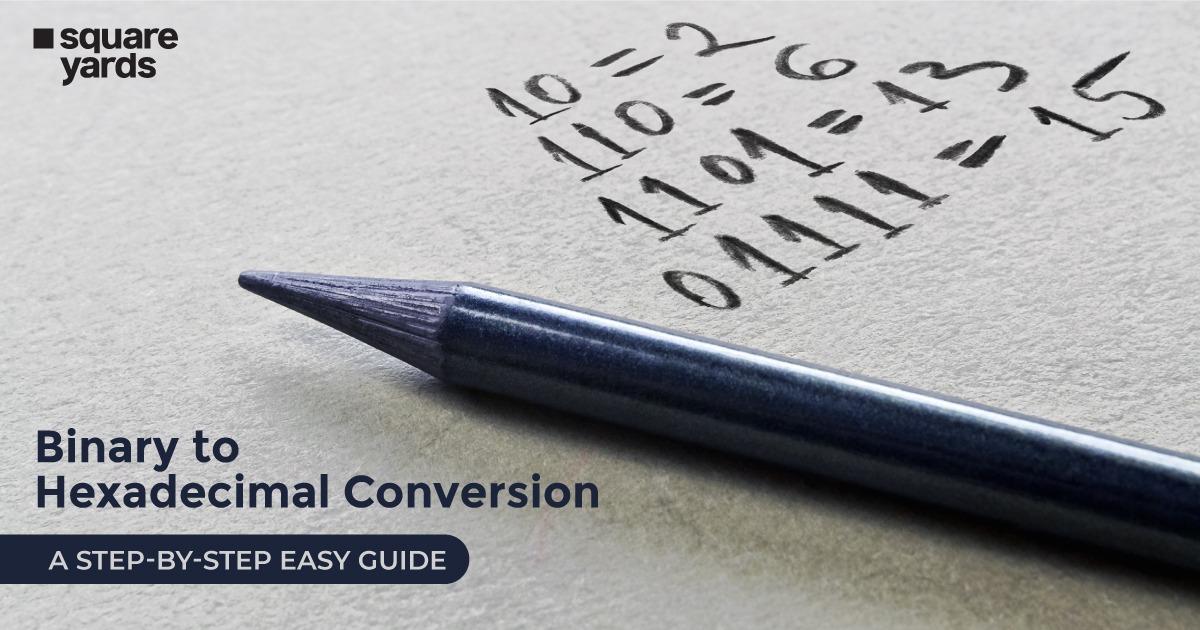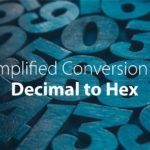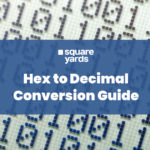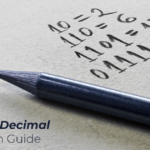In our modern era dominated by technology and gadgets, grasping the fundamentals of number systems is paramount. From the devices we interact with a daily routine to the intricate workings of computers, numbers underpin it all. Among the core conversions is binary to hexadecimal, an elementary process that converts the binary language of machines to the more human-friendly hexadecimal code.
This blog delves into the conversion techniques, their significance and valuable tips to unravel the numerical magic of binary to hexadecimal.
Table of contents
What Is Binary?
The binary is one of the simplest number systems that use only two numeric symbols, 0 and 1, to represent all the numbers. It represents base number 2 and is essential in computing, programming and telecommunications. Digits 0 and 1 are called bits; a byte comprises 8 bits. For example, the binary numbers are (100100)2,(1110011)2, and other numbers like 2,3,4,5 are not included in this system.
In the binary system, each digit starts from 2^0 (1) and increases by a factor of 2 for each subsequent position to the left.
Let’s take an example: Convert binary to hexadecimal
1000= 1 x 23 + 0 x 22 + 0 x 21 + 0 x 20
= 8 + 0 + 0 + 0
= 8
Current Use of Binary
Binary coding, the primal language of computers and electronic devices is the foundation for storing data information and computing. Computers don’t understand number systems as we do. They retrieve instructions or information using switches that can be represented in two ways (on or off). Here, the binary system is the solution, 1 denotes “On”, and 0 illustrates “Off”. Every digit refers to as a bit, and 8 bits make bytes. Using this coding system, computers extract accurate information, streamline complex operations and enhance efficiency.
History of Binary
The discovery of the binary number system is credited to German mathematician and philosopher of the 17th century, Gottfried Wilhelm Leibniz. Also, known as the father of the binary code, he developed a system using the two binary digits 0 and 1, and each numeral corresponds to an exponential power of 2. However, the binary system found its notable practical application in the 19th century when George Boole further evolved the theory in his Boolean algebra, forming the basis of modern digital circuits.
The binary system emerged in the 20th century when George Stibitz developed the first modern digital computer using binary coding language.
What Is Hexadecimal?
A hexadecimal number system or hex is a base-16 number system that consists of sixteen distinct symbols to represent numbers, including 0-9 (0,1,2,3,4,5,6,7,8,9) and A-F (A, B, C, D, E, F) where A to F represent the decimal numbers 10 to 15.
Each digit in this numeric system represents a power of 16.
Similarly, like a binary system, it starts from 16^0 (1) and increases by a factor of 16 for each subsequent position to the left. For example, 4A7C16, 3FB16, 6D5C16
Let’s explain- 4A7C16
4 x 163 + 10 x 162 + 7 x 161 + 12 x 160
= 4 x 4096 + 10 x 256 + 7 x 16 + 12 x 1
= 16,384+ 2560+ 112+ 12
= 19,068
Programmers and engineers utilise hexadecimal number system to represent binary numbers in a more compact and easily readable manner. Conversions between binary to hexadecimal become seamless since each digit in hexadecimal corresponds to four binary digits (bits).
Current Use Of Hexadecimal
Hexadecimal number systems are used by programmers in debugging, fixing errors, and memory addressing to simplify the process. This is particularly utilised when dealing with MAC addresses and assembly language programming. A group of 12 hexadecimal numbers are found in MAC addresses.
Furthermore, hexadecimal notation finds utility in web design for creating aesthetic websites, specifically in colour codes expressed as #RRGGBB, where RR denotes red, GG signifies green, and BB represents blue.
History Of Hexadecimal
The history of the hexadecimal number system finds its roots in introducing the IBM System/360 during the 1960s when engineers needed a standardised approach to represent binary data efficiently.
In the 1950s, before the establishment of the hexadecimal system, certain computing facilities opted for the characters 0 to 5 in combination with a macron (“¯”) character to signify numerical values ranging from 10 to 15. However, this approach faced criticism from the community and the theory was deserted.
Then, a distinguished mathematician, Bruce A. Martin, proposed another alternative- Adding symbols from A to F for numeric values greater than nine, such as A for 10, B for 11, and so forth, offering a more logical representation. Today, this system facilitates seamless computation and data information.
Relationship Between Binary And Hexadecimal
The relationship between a hexadecimal number and a binary number system is like an interconnected world of numerical representation.
Binary, the foundation of modern digital computing, uses only two symbols- 0 and 1 with 2 as a base-number system. As discussed above, it works on the principle of electric switches “off” (0) and “on” (1).
On the other hand, hexadecimal comprises 16 symbols: decimal digits 0-9 and letters A-F, with A representing 10 and F representing 15.
This base-16 numeral system allows for a more compact representation of binary data, as each hexadecimal digit corresponds to a group of four binary digits (bits). For example, the hexadecimal digit 9 corresponds to the binary 1001. Similarly, the hexadecimal digit F corresponds to the binary 1111.
How To Convert Binary To Hexadecimal?
There are two ways to convert binary to hex:- First is to follow the binary to hexadecimal converter table that simplifies the process.
| Hexadecimal | Binary |
| 0 | 0000 |
| 1 | 0001 |
| 2 | 0010 |
| 3 | 0011 |
| 4 | 0100 |
| 5 | 0101 |
| 6 | 0110 |
| 7 | 0111 |
| 8 | 1000 |
| 9 | 1001 |
| A | 1010 |
| B | 1011 |
| C | 1100 |
| D | 1101 |
| E | 1110 |
| F | 1111 |
Next, the method involves the conversion of binary to decimal number system. Then, this decimal figure is converted to a hexadecimal number—step-by-step Conversion.
- First, Convert the binary number to decimal.
- Convert the decimal figure to hexadecimal.
Regardless of your approach, one can effortlessly convert these number systems with a solid understanding of binary to hexadecimal formulas and conversion techniques.
Formula And Examples Of Binary To Hexadecimal Conversion
Let’s explore both methods in detail with the following examples that can help you understand the conversion process.
1st Method- Convert Binary 10110101 to Hex
First, group the numbers in four sets since each hexadecimal number corresponds to a group of four binary numbers.
From the above conversion table:-
1011 0101
= B 5
= (B5)16
2nd Method- Convert Binary 11011001 to Hex
First convert this binary number into a decimal number
(11011001)= 1×27 + 1x 26 + 0x 25 + 1 x 24 + 1 x 23 + 0 x 22 + 0 x 21 + 1 x 20
= 128+ 64+ 0+ 16+ 8+ 0+ 0+ 1
= (217)10
Convert this number to hexadecimal, dividing by 16 until the quotient is zero.
| Divide by 16 | Quotient | Remainder | Hex Value |
| 217 ÷ 16 | 13 | 9 | 9 |
| 13 ÷ 16 | 0 | 13 | D |
(217)10 = (D9)16
Therefore, the final result of (11011001)2 = (D9)16
Don’t miss It!
| Kilometer to Centimeter | Kilometer to Centimeter Conversion: Conversion Table, Examples |
| Centimeter to Meter | How to Convert Centimeter to Meter: Formula & Examples |
| Cubic Meter to Liter | How to Convert Cubic Meter to Liter: Formula & Examples |
| Cent to Square Feet | How to Convert Cent to Square Feet: Formula & Examples |
| Pounds to Kilogram | How to Convert Pounds to Kilogram: Formula & Examples |
| Milligrams to Grams | How to Convert Milligramsto Grams: Formula & Examples |
| Yard to Feet | How to Convert Yard to Feet Formula & Examples |
| Binary to Decimal | How to Convert Binary to Decimal: Formula & Examples |
Hexadecimal To Binary Conversion Table
One of the quickest way to convert binary to hexadecimal is to use the following conversion table.
| Hexadecimal | Binary |
| 0 | 0000 |
| 1 | 0001 |
| 2 | 0010 |
| 3 | 0011 |
| 4 | 0100 |
| 5 | 0101 |
| 6 | 0110 |
| 7 | 0111 |
| 8 | 1000 |
| 9 | 1001 |
| A | 1010 |
| B | 1011 |
| C | 1100 |
| D | 1101 |
| E | 1110 |
| F | 1111 |
Difference Between Binary And Hexadecimal
The difference between binary and hexadecimal is tabulated below:
| Binary | Hex |
| Binary uses two symbols, 0 and 1. | Hex uses 16 symbols (0-9 and A-F). |
| In Binary, the exponential power is 2 ( 2, 4, 16, etc). | In hex, the exponential power is 16 (16, 256, 4096, etc.) |
| The smallest unit is Bit (0 or 1) | Smallest Unit is Nibble (4 bits). |
| It is a direct representation of bits. | Each hex digit number Corresponds to groups of four binary bits. |
| Lengthy and complex data | Concise and readable representation. |
| Fundamental in data storage and digital computing. | Widely utilised in debugging, machine instructions and MAC addresses. |
In a Nutshell
Understanding the binary to hexadecimal conversion empowers us to bridge the world of computing and digital communication. Follow the step-by-step guide to master the technical skill, simplify coding language and bring ease in readability.
FAQ’s about Binary to Hexadecimal
Q1. How do I convert from binary to hexadecimal?
There are two methods for binary to hexadecimal conversion:-
The first uses the conversion table, where each hexadecimal number equals four binary digits. The second method is converting binary to a decimal number and then to hexadecimal.
Q2. What is hexadecimal 999 in binary?
Let’s convert (999)16 to binary=
From the above table
9 9 9
= 1001 1001 1001
= (100110011001)2
Q3. Is hexadecimal 6 or 16?
Hexadecimal is a numbering system with a base 16 that uses sixteen digits from 0-9 and A-F to represent numbers. Engineers and programmers in computing and assembly language programming utilise it.




















